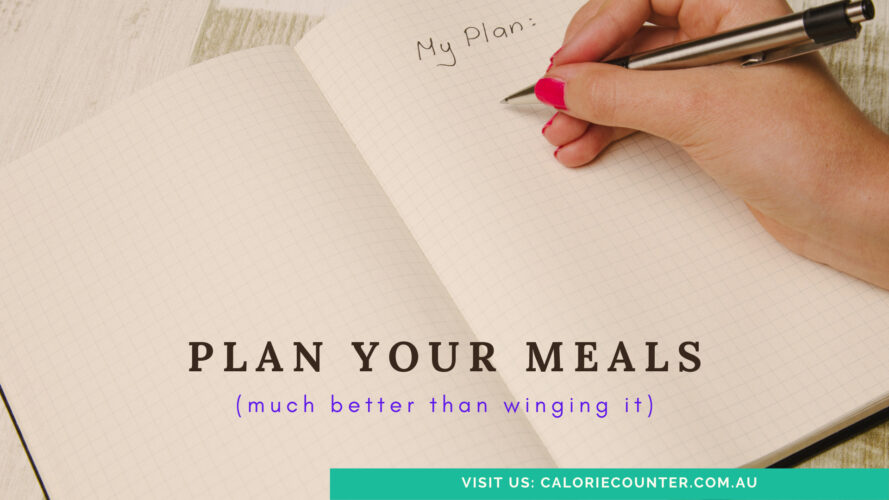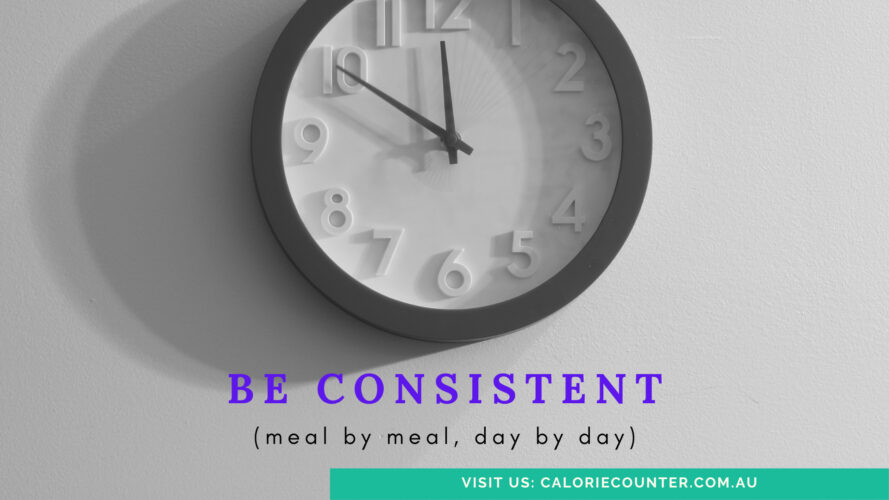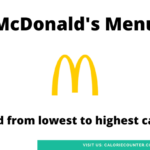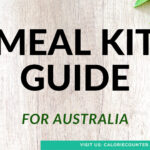We’re all about calorie counting over here at calcount, and this article give you the fundamentals of how to count calories in order to lose weight. At it’s essence, calorie counting is a method of tracking the number of calories you consume in a day in order to lose weight.
Here is a step-by-step guide on how you can start calorie counting today:

Determine your daily calorie needs
There are a few different ways to determine your daily calorie needs, including:
Using our Calorie Tracker,
Our Calorie Tracker uses your age, weight, height, and activity level to estimate your daily calorie needs.
Using a formula
The Harris-Benedict equation is a commonly used formula to estimate daily calorie needs. It calculates your Basal Metabolic Rate (BMR) and then multiplies it by a factor based on your activity level. Don’t worry, you don’t have to memorise anything, just use calcount’s Calorie Calculator!
Consulting a professional
A registered dietitian or a physician can help you determine your daily calorie needs by taking into account your health history, weight loss goals, and any other factors that may be relevant.
It’s important to note that these calculations are estimates and that individual calorie needs can vary greatly. It’s also important to be mindful of your body’s response and adjust your calorie intake accordingly.

Keep track of your calories
You can track the calories you eat by:
Use a food diary
Write down everything you eat and drink, along with the corresponding calorie count. This can be done with a physical notebook or the notes app on your phone.Use a calorie-tracking app: There are many apps available for both smartphones and computers that allow you to track your calories by searching for foods in a database. One of the best is (of course!) our own Calorie Tracker!
Use the nutrition label
Most packaged foods have a nutrition label on the back that lists the number of calories per serving.
Learn to estimate
Becoming familiar with the calorie content of common foods will help you to estimate the calorie content of meals that are not packaged or restaurant meals.Keep it simple: Tracking your food intake can be time-consuming. Set realistic goals for yourself and try to make it as simple as possible.
Be consistent
Tracking your calories every day will give you the most accurate picture of your intake.
Be honest
Be honest with yourself about what you are eating. Do not underestimate or overestimate the amounts or calorie content of foods you are consuming.
Remember, the goal of calorie counting is not to restrict yourself, but rather to become more aware of your food choices and make healthier decisions.

Understand serving sizes
Be sure to measure and weigh your food to ensure you are accurately tracking the number of calories consumed. Understanding serving sizes is an important aspect of calorie counting and controlling portion sizes in order to lose weight. Here are a few ways to understand and control serving sizes:
Use measuring cups and spoons
This will help you to accurately measure the serving size of foods such as rice, pasta, and cereal.
Use a food scale
This will help you to accurately measure the weight of foods like meat, fish, and cheese.
Look at the nutrition label
Most packaged foods have a nutrition label on the back that lists the number of servings per container and the serving size in both weight and volume.
Learn to estimate
Becoming familiar with the typical serving sizes of common foods will help you to estimate the serving size of foods that do not have nutrition labels.
Be mindful of restaurant portion sizes
Restaurant portions are often larger than recommended serving sizes. Consider sharing a dish or taking half of your meal home for leftovers.
Practice mindful eating
Eating slowly and paying attention to your body’s hunger and fullness signals can help you to better control your portion sizes.
Use smaller plates
Studies have shown that using smaller plates can lead to smaller portion sizes and ultimately help you consume fewer calories.
Aim for balance in your diet and not to control yourself too much. It’s also important to remember that controlling portion size is not only about weight loss but also maintaining a healthy weight and overall health.

Plan your meals
Use your daily calorie needs as a guide for how much to eat at each meal. Aim for a balance of protein, carbohydrates, and healthy fats. Planning your meals is an important aspect of limiting calories and losing weight. Here are a few tips on how to effectively plan your meals:
Make a list
Plan out your meals for the week, taking into account your daily calorie needs and any specific dietary restrictions.
Use a meal planning template
There are many templates available online that can help you plan your meals and track your calories. You can use calcount’s Calorie Tracker to plan your meals in advance and track your calories.
Focus on nutrient-dense foods
Prioritize nutrient-dense foods such as fruits, vegetables, whole grains, lean proteins, and healthy fats in your diet.
Cook at home
Cooking your own meals gives you more control over portion sizes and the ingredients used.
Be prepared
Prepare meals in advance, or at least have the ingredients on hand, so that you always have a healthy option available.
Be flexible
Remember that it’s okay to have a treat once in a while, and don’t be too hard on yourself if you slip up.
Consult a professional
If you’re unsure about what a healthy diet looks like, or have any health concerns, consult a registered dietitian or a physician.
Successful weight loss is not just about strict restriction, but instead about finding a sustainable balance. Plan your meals in a way that allows you to enjoy your food, and make healthy choices, while still reaching your weight loss goals.

Be consistent
Tracking your calories every day will give you the most accurate picture of your intake. Consistency is important when trying to lose weight by counting calories because it helps you to accurately track your food intake and stay within your daily calorie budget.
When you’re consistent with your meal planning and tracking, you will have a better understanding of the foods you are eating and the number of calories you are consuming.
Track Progress
Consistency allows you to accurately track your progress and make adjustments as needed. If you’re inconsistent with your calorie tracking, it will be difficult to know if you’re on track to reach your goals.
Identify patterns
Consistency helps you to identify patterns in your eating habits, such as overeating at certain times of the day or reaching for high-calorie foods when you’re stressed. This can help you to make healthier choices in the future.
Avoid overeating
Consistency helps to prevent overeating and overshooting your calorie budget. When you’re consistent with your tracking, you’re more likely to stay within your daily calorie limit.
Build a sustainable lifestyle
Consistency is key in building a sustainable lifestyle change. Inconsistent eating and meal planning habits can lead to frustration and a sense of failure, which can discourage you from continuing with your weight loss journey.
As we’ve said before, losing weight is a long-term process, and consistency is crucial for success. It’s also important to note that being consistent doesn’t mean being perfect, it’s about staying on track and making adjustments as needed.

Make adjustments
If you find that you are consistently going over your daily calorie needs, make adjustments to your diet by cutting back on high-calorie foods or increasing your physical activity. If you find that you’re consistently missing your calorie control goals, here are a few ways you can adjust your eating habits to get back on track:
Re-evaluate portion sizes
Take a closer look at your portion sizes and adjust as needed to better control your calorie intake.
Make healthier food choices
Focus on nutrient-dense foods such as fruits, vegetables, whole grains, lean proteins, and healthy fats.
Be mindful of snacking
Snacking can quickly add up to a lot of extra calories, so be mindful of what and how much you’re snacking on.
Keep track of all food and drinks
Be sure to track all food and drinks, including condiments, oils, and snacks.
Be mindful of eating out
Eating out can be difficult to track, but try to make healthy choices and ask for dressing or sauces on the side.
Avoid skipping meals
Skipping meals can lead to overeating later in the day, so aim to have consistent meals throughout the day.
Increase physical activity
Increasing physical activity can help to burn additional calories and support weight loss.
Get support
Consider joining a support group or reaching out to a registered dietitian or a physician for additional guidance and support.
Weight loss is a journey, and it’s important to be patient with yourself and make adjustments as needed. Small changes can add up over time, so be kind to yourself and celebrate your progress, no matter how small.

Don’t forget to include exercise
Physical activity not only burns calories but also helps to build muscle, which will boost your metabolism and help you burn more calories at rest. Introducing regular physical exercise to your day can be a great way to support weight loss and improve overall health. Here are some tips for getting started:
Start slow
If you’re new to physical exercise, start with 10-15 minutes of light activity and gradually increase over time.
Find an activity you enjoy
Try different types of physical activity until you find one you enjoy, such as walking, biking, swimming, or dancing.
Make it a routine
Incorporate physical activity into your daily routine by scheduling it at the same time each day.
Make it social
Exercise with a friend, join a class, or participate in a sport to make it more enjoyable and help you stay accountable.
Mix it up
Try different types of physical activity to prevent boredom and to challenge different muscle groups.
Listen to your body
Start slowly and listen to your body. If you feel pain or discomfort, stop and consult a physician.
Be patient
Physical activity is a process, and it may take time to see results. Be patient, and celebrate your progress, no matter how small.
Physical activity doesn’t have to be intense to be effective. Start slow, find an activity you enjoy, and gradually increase over time. Your goal should be to find a physical activity that is sustainable and enjoyable, rather than one that you dread.

Consult a professional
If you are unsure about your daily calorie needs, or have any health concerns, consult a registered dietitian or a physician. Consulting a dietitian is important when planning to lose weight by calorie restriction for several reasons:
Personalised recommendations
A dietitian can help you create a personalised nutrition plan based on your individual needs and goals. They can assess your current eating habits, lifestyle, and medical history, and recommend a plan that is safe and effective for you.
Expert guidance
Dietitians are trained and licensed professionals who have the expertise to guide you through the weight loss process. They can help you understand the science behind calorie restriction and weight loss and provide you with practical tips and strategies for success.
Safe and healthy weight loss
A dietitian can ensure that your calorie restriction plan is safe and healthy. They can help you make sure you’re getting adequate nutrition and avoiding deficiencies and help you to make healthy food choices.
Support and accountability
Dietitians can provide you with ongoing support and accountability as you work towards your weight loss goals. They can help you track your progress, adjust as needed, and provide you with encouragement and motivation along the way.
Addresses underlying health conditions
A dietitian can also help you address any underlying health conditions, such as diabetes or heart disease, that may impact your weight loss journey.
In conclusion, consulting a dietitian can help you to lose weight in a safe and healthy way, and increase your chances of success. They can provide you with personalized recommendations, expert guidance, and ongoing support and accountability as you work towards your weight loss goals.
How to Count Calories the Healthy Way
Now you know how to count calories so that you can lose weight sustainably, the healthy way. If you’ve made the decision to start, good on you! You’re about to become much more aware of what you eat, when you eat it, and what effect your food has on your body weight and wellbeing.
But, first things first, get your free Calorie Tracker account right now!









